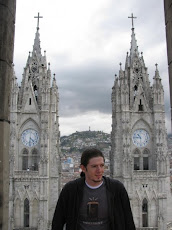
If there’s one hot topic about travelling abroad, it’s food. Rightly so, eating is kind of important to sustain life. Ten days in seemed like a good time to give a run down about the dining options here.
I would be amiss if I didn’t start with fruit. It is, by far, the biggest food source here. It’s in the drinks, it’s what’s for breakfast, and it’s what’s for dessert. Sounds like a little much, right? Well, it would be if there wasn’t an extensive variety. From guanabana to tomate de arbol, there are tons of choices, most of which aren’t even available in the U.S. (much like the naranjilla pictured above).

I won’t comment on what I’ve thought of it much because I’m no authority. However, I will say I’ve tried everything offered and in so many ways I couldn’t even comprehend. Banana chips (exactly like potato chips, but bananas instead), smoothies, juices, milkshakes, ice cream, pie, raw, in yogurt, etc.- they’ve all been different and great experiences. (In case you really are curious, the
piña (pineapple) and
mora (blackberry) stuff has been my favorite by far.
We should move on to soup. It’s HUGE here. I’ve always hated it in the States, but I promised to be a little more open here with my food choices. Thank goodness for that because almost every traditional meal we’ve had here has included soup as the first course. It’s actually been very delicious in most cases and generally is broth-like with a potato or bit of chicken for substance.
The soup is only the first course. In most meals we’ve had, they’ve at least contained two courses. The second course generally contains some version of corn (there are dozens of varieties served, but my favorite has been Choclo with queso, as evidenced by its destruction in the picture below left).
Dinner also usually features a small portion of vegetables (usually a potato or yuca because both are easily grown in the mountains) and sometimes a small portion of meat (chicken has been very popular, but we’ve also had a jerkey-like meat a few times).
As for my opinion, it’s all been very good. The corn is NOT the same as in the US. You can forget the butter and salt, but the cheese that I mentioned compliments it just as well. The meat is deliciously seasoned, and the chicken is usually baked, not fried. It’s just as delicious though. I’ve been very content with the main courses on the whole.
And now for beverages:
Beer is immensely popular here and comes in two cheap types: Pilsener and Club. They’re served for about a dollar in every store, restaurant, and even hostel with practically no exception.
Water is bottled, and I’ve found that Ecuadorians enjoy club soda just as much as normal water. So, if looking for regular water like in the states, one must ask for agua sin gas (water without carbonation).
Soda is big here too, of course. Coke, made from sugar cane instead of corn syrup, is much better than in the States and seems to be the most popular soft drink. Sprite and Fanta seem to be popular choices too.
Finally, juice, as I said above in the fruit section, is always an option.
Well that’s my run down about food… Buen provecho!
Nick Bratcher























































